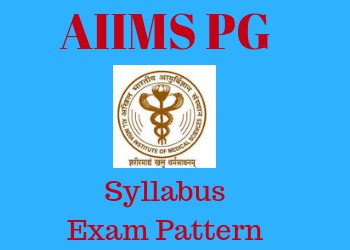NEET 2019 Syllabus – Aspiring candidates must know the NEET 2019 syllabus in details. Once they know the syllabus thoroughly, they will be able to start their preparation accordingly. The sooner they start their preparation, the more confident they will be before the examination commences. Earlier, NEET was conducted by CBSE and used to be held twice a year. However, from 2019, this national level medical entrance exam will be conducted once a year by the National Testing Agency (NTA). The exam will be conducted in offline mode.
Overview: NEET 2019 Examination
| Name of the Examination | National Eligibility cum Entrance Test |
| Examination Conducting body | National Testing Agency (NTA) |
| Examination level | National |
| Category | Undergraduate |
| Purpose of examination | Admission to medical, dental and AYUSH courses in India (except AIIMS and JIPMER) |
NEET 2019 Exam Pattern
Mentioned herein below is the NEET 2019 exam pattern. Knowing the exam pattern will help the candidates to have an idea of how to make a strategy to study for the entrance exam.
| Particulars | Details |
| Mode of examination | Offline (Pen and Paper mode)
|
| Duration of Examination | 3 hours |
| Total Number of Questions | 180 Questions |
| Sections | Physics – 45 Questions
Chemistry – 45 Questions Biology – 90 Questions |
| Marking Scheme | +4 marks for each correct answer;
-1 mark for each incorrect answer; 0 mark for each unanswered question |
| Maximum Marks | 720 marks |
| Aggregate score calculation | Total number of correct answers X 4 – Total number of incorrect answers X 1
(Note: There will be no marks for not attempting questions) |
NEET 2019 Syllabus Details
The NEET 2019 syllabus is mentioned here thoroughly. Candidates can take a look at the tables mentioned below and get started with their preparation for the medical entrance examination.
Physics
| Class 11 | CLASS 12 | |
| Unit | Topic/Chapters | Topic/Chapters |
| I | Physical world and measurement | Electrostatics |
| Chapter-1: Physical World | Chapter-1: Electric Charges and Fields | |
| Chapter-2: Units and Measurements | Chapter-2: Electrostatic Potential and Capacitance | |
| II | Kinematics | Current Electricity |
| Chapter-3: Motion in a Straight Line | Chapter-3: Current Electricity | |
| Chapter-4: Motion in a Plane | Magnetic Effect of Current & Magnetism | |
| III | Laws of Motion | Chapter-4: Moving Charges and Magnetism |
| Chapter-5: Laws of Motion | Chapter-5: Magnetism and Matter | |
| IV | Work, Energy and Power | Electromagnetic Induction & Alternating Current |
| Chapter-6: Work, Energy and Power | Chapter-6: Electromagnetic Induction | |
| V | Motion of System of Particles and Rigid Body | Chapter-7: Alternating Current |
| Chapter-7: System of Particles and Rotational Motion | Electromagnetic Waves | |
| VI | Gravitation | Chapter-8: Electromagnetic Waves |
| Chapter-8: Gravitation | Optics | |
| VII | Properties of Bulk Matter | Chapter-9: Ray Optics and Optical Instruments |
| Chapter-9: Mechanical Properties of Solids | Chapter-10: Wave Optics | |
| Chapter-10: Mechanical Properties of Fluids | Dual Nature of Matter and Radiation | |
| Chapter-11: Thermal Properties of Matter | Chapter-11: Dual Nature of Radiation and Matter | |
| VIII | Thermodynamics | Atoms & Nuclei |
| Chapter-12: Thermodynamics | Chapter-12: Atoms | |
| IX | Behaviour of Perfect Gas and Kinetic Theory | Chapter-13: Nuclei |
| Chapter-13: Kinetic Theory | Electronic Devices | |
| X | Oscillation & Waves | Chapter-14: Semiconductor Electronics |
| Chapter-14: Oscillations | ||
| Chapter-15: Waves |
Chemistry
| Class 11 | CLASS 12 | |
| Unit | Topic/Chapters | Topic/Chapters |
| I | Basic Concepts of Chemistry | Solid State |
| II | Structure of Atom | Solutions |
| III | Classification of Elements & Periodicity in Properties | Electrochemistry |
| IV | Chemical Bonding and Molecular Structure | Chemical Kinetics |
| V | States of Matter: Gases and Liquids | Surface Chemistry |
| VI | Thermodynamics | Isolation of Elements |
| VII | Equilibrium | p-Block Elements |
| VIII | Redox Reactions | d- and f-Block Elements |
| IX | Hydrogen | Coordination Compounds |
| X | s-Block Elements | Haloalkanes and Haloarenes |
| XI | Some p-Block Elements | Alcohols, Phenols and Ethers |
| XII | Organic Chemistry: Basic Principles & Techniques | Aldehydes, Ketones and Carboxylic Acids |
| XIII | Hydrocarbons | Organic Compounds containing Nitrogen |
| XIV | Environmental Chemistry | Biomolecules |
| XV | Polymers | |
| Chemistry in Everyday Life |
Biology
| Class 11 | CLASS 12 | |
| Unit | Topic/Chapters | Topic/Chapters |
| I | Diversity of Living Organisms | Reproduction |
| Chapter-1: The Living World | Chapter-1: Reproduction in Organisms | |
| Chapter-2: Biological Classification | Chapter-2: Sexual Reproduction in Flowering Plants | |
| Chapter-3: Plant Kingdom | Chapter-3: Human Reproduction | |
| Chapter-4: Animal Kingdom | Chapter-4: Reproductive Health | |
| II | Structural Organisation in Plants & Animals | Genetics and Evolution |
| Chapter-5: Morphology of Flowering Plants | Chapter-5: Principles of Inheritance and Variation | |
| Chapter-6: Anatomy of Flowering Plants | Chapter-6: Molecular Basis of Inheritance | |
| Chapter-7: Structural Organisation in Animals | Chapter-7: Evolution | |
| III | Cell: Structure and Function | Biology and Human Welfare |
| Chapter-8: Cell-The Unit of Life | Chapter-8: Human Health and Diseases | |
| Chapter-9: Biomolecules | Chapter-9: Strategies for Enhancement in Food Production | |
| Chapter-10: Cell Cycle and Cell Division | Chapter-10: Microbes in Human Welfare | |
| IV | Plant Physiology | Biotechnology and its Applications |
| Chapter-11: Transport in Plants | Chapter-11: Biotechnology – Principles and Processes | |
| Chapter-12: Mineral Nutrition | Chapter-12: Biotechnology and its Application | |
| Chapter-13: Photosynthesis in Higher Plants | Ecology and Environment | |
| Chapter-14: Respiration in Plants | Chapter-13: Organisms and Populations | |
| Chapter-15: Plant – Growth and Development | Chapter-14: Ecosystem | |
| V | Human Physiology | Chapter-15: Biodiversity and its Conservation |
| Chapter-16: Digestion and Absorption | Chapter-16: Environmental Issues | |
| Chapter-17: Breathing and Exchange of Gases | ||
| Chapter-18: Body Fluids and Circulation | ||
| Chapter-19: Excretory Products and Their Elimination | ||
| Chapter-20: Locomotion and Movement | ||
| Chapter-21: Neural Control and Coordination | ||
| Chapter-22: Chemical Coordination and Integration |
NEET 2019 Sample Papers
The aspiring candidates also need to make sure that they go through NEET 2019 sample papers. In fact, going through the sample papers and solving those will help them to get an idea of how much time they would need to solve a particular section. They will also get an idea of the types of questions they will come across in the entrance test.





